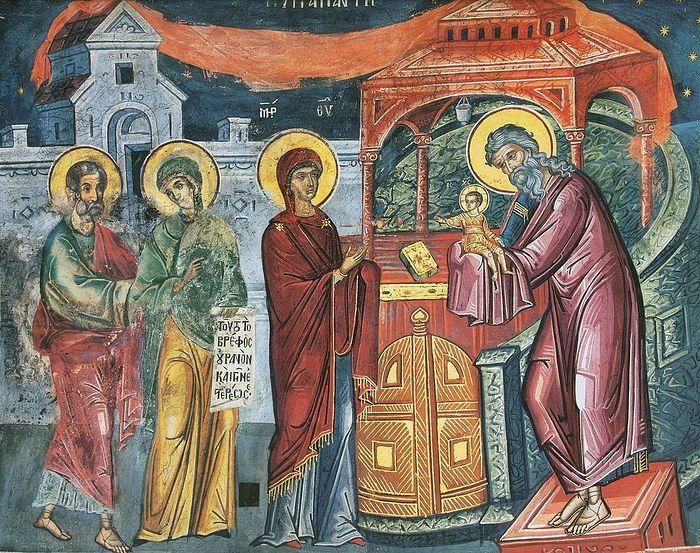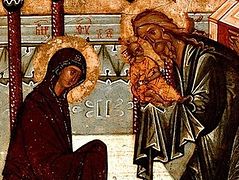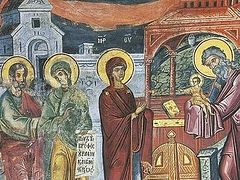Source: The Panagia: She Who is Quick to Hear
February 8, 2016
Beloved of God, this feast of the Meeting of the Lord is unique in the sense that there are a variety of points set forth. To begin with, in Christ, we see the fulfillment of the Law, And the Lord spake unto Moses saying, sanctify unto me all the firstborn, whatsoever openeth the womb among the children of Israel, both of man and of beast: it is mine (Ex. 13:1-2). The ninth ode of the canon speaks of this: “In the shadow and the letter of the Law, let us, the faithful discern a figure: every male child that opens the womb shall be sanctified to God.”[1] So this Law pointed to Christ Who is the “firstborn Son and Word of the Father without beginning, the firstborn Child of a Mother who had not known man.”[2] This feast, then, returns us to the theme of the Incarnation of our Lord Jesus Christ—God the Word, the firstborn and only-begotten Son of the Father becomes the firstborn and only-begotten Child of a virgin mother. The hymns speak of His assumption of our human nature and its result: our salvation.
Next we have His most pure Mother, our Lady Theotokos, coming with the Christ-Child to the Temple in order to fulfill the rite of purification prescribed by the Law of Moses. Finally, we have the encounter of the righteous Simeon with our Lord; he takes into his arms Jesus—the eternal God become a babe—and declares that He is the Savior of the world. Today let us consider the second of these themes we have mentioned, and speak specifically about Mary, the Mother of God, coming to the Temple to fulfill the Jewish rite of purification for a woman after childbirth.
A question could be raised: Did the Theotokos need purification? Was she unclean according to the Law of Moses? What does the consciousness of the Church tell us? She was neither unclean nor in need of purification. Just as her Son our Lord Jesus Christ went to baptism with no need for it but rather to fulfill all righteousness (Mat. 3:15), so too, His most pure Mother, although she was not in need of purification, submitted to the law. Perhaps a question could be raised based on the Gospel narrative concerning this event? Doesn’t it say: when the days of her purification according to the Law of Moses were fulfilled (Luke 2:22). Since the Gospel says her purification, one could conclude that this must indicate she needed it. However, the King James Version is being quoted here, and it is this or the New King James version which are used in most of our parishes. This latter also says her purification. Unfortunately it is a mistranslation, the original Greek is plural, it says, tou katharismou auton, the pronoun is plural, it would be properly translated as their purification, and not her purification. Yet the law itself, which she came to fulfill does use the singular, and refers specifically to the woman who gave birth, it states: And when the days of her purifying are fulfilled (Lev. 12:6). But by changing the pronoun to the plural, St. Luke is referring to the purification of the Jews prescribed by the Law of Moses to which the Mother of God submitted although she had no need.[3]
So then, exactly what does this law say about the purification of women? In the book of Leviticus we read:
And the Lord spake unto Moses, saying, “Speak unto the children of Israel, saying, If a woman have conceived seed, and born a man child: then she shall be unclean seven days; and in the eighth day the flesh of his foreskin shall be circumcised. And she shall then continue in the blood of her purifying three and thirty days” (Lev. 12: 1-4).
We see, then, that it was in giving birth through conception by seed, and by the loss of blood, that the new mother was considered unclean, and so in need of purification. In the Law, the loss of seed or blood, and childbirth are spoken of as making one unclean, and of the second it is specifically written the life of the flesh is in the blood (Lev. 17:11). These types of “uncleanness” were not thought of as a voluntary act of sin, but rather as a diminution in vitality of life, and an involuntary separation from God.
However, with the Mother of God, there was “a conception without seed,”[4] we know it was without the touch of man but rather that which was conceived in her was of the Holy Ghost (Mat. 1:20). Yet what about the birth giving, was it natural? Was the birth of the pre-eternal uncreated God, according to the flesh, natural? It had both a natural and supernatural aspect. It was natural only in the aspect that the Son of God did pass through her womb with our human nature that He assumed from her. Again, it was above nature, for we confess the Theotokos to be virgin before, during, and after birth giving. Physically she is ever-virgin. Although Christ passed through her womb He kept it sealed. Even though we may occasionally have a hymn as in the Vespers service last night which said: “Now the God of purity as a holy child has opened a pure womb,”[5] we still need to keep our thoughts within the tradition of our Orthodox faith. We should not conclude that the seal of her virginity was broken. This, of course, is not the teaching of the Church, it is false. The expression of opening the womb is an allusion back to the Old Testament law, and in this context it is actually another way of saying first-born.[6]
Now let us continue with the miraculous birth giving. The Theotokos had no birth pangs, for the birth of God was not subject to the curse that sprang from the disobedience of Eve. This was foretold by the Prophet Isaiah: Before she travailed, she brought forth; before her pain came, she was delivered of a man child (Isa. 66:7). But did she have a flow of blood and so become unclean? No! In our services there are countless references where it is stated that she experienced no harm at all in her birth giving. In particular let us look at one, the hymn to the Theotokos that ends the Lord I call verses at the Saturday evening Small Vespers in the fifth tone. It says: “He [Christ] passed through the gates of virginity, and no diminution was left behind in it.”[7] The pronoun “it” refers back to virginity. Furthermore bleeding would mean that the seal of her virginity was broken, and we know she continued a virgin. And even that moment of the birth-giving itself is a mystery known only to God and her, for Joseph the Betrothed left her alone in the cave and went to seek a mid-wife. Having found a pair and returned, he beheld a luminous cloud over the cave, which disappeared followed by a light in the cave and on entering he saw the Theotokos with the Christ-Child. One of the midwives whom the Theotokos permitted to examine her declared: “there has been no spilling of blood in his birth, no pain in bringing him forth. A virgin has conceived, a virgin has brought forth, and a virgin she remains.”[8]
But let us go on to further establish the points we have made and listen to the words of St. Dimitri of Rostov—a small excerpt from a sermon on today’s feast:
Fulfilling this law of the Lord, the Mother of God came into the temple with the Lawgiver. She came to purify herself, although she had no need of purification since she was undefiled, without offense, uncorrupted, most pure. For she who conceived without a man or desire, and gave birth without pain or violation of her virginal purity, was not tainted by the impurity common to women who give birth according to the law of nature. For how could impurity touch her who gave birth to the Source of purity? Christ was born of her like fruit from a tree. And as the tree producing its fruit is neither harmed nor defiled, in the same manner at the birth of Christ—the Blessed Fruit—the Virgin remained unharmed and undefiled. Christ proceeded from her as a ray of the sun that passes through the glass or crystal. In passing through glass or crystal, a sunray does not break up or damage it, but illumines it even more. And Christ, the Sun of Righteousness, did not harm the virginity of His Mother. And the door of natural birth was sealed in purity and preserved in virginity not being defiled with a flow of blood as is common to women. But having passed through her supernaturally, He increased her purity, having sanctified and enlightened her with the light of Divine grace by His proceeding from her. Any purification was absolutely unnecessary for her who gave birth without defilement to God the Word. But in order not to break the law, but to fulfill it, she came to purify herself having all-perfect purity and without any blemish. At the same time, filled with humility, she was not proud of her uncorrupted purity, but she came as if unclean to stand together with the unclean women in front of the doors of the temple of the Lord, and besought purification, not disdaining those who were unclean and sinful.[9]
Thus did our holy hierarch Dimitri speak of our Lady Theotokos. So keeping the purity of our all-holy Lady Theotokos in mind let us increase our love for her and also strive for this virtue of purity. Through her prayers combined with our struggles, may Christ our God purify us from the defilement of sin and passions, and so make us worthy in the life to come with faces unashamed to look upon Him, together with His unoriginate Father, and His most-holy, good and life-creating Spirit, throughout the endless ages, world without end. Amen.
Originally printed in O Full of Grace Glory to Thee (New Zadonsk Press, 2008)




articles everyday. I am not disappointed but uplifted and blessed. God bless and keep you, Photini